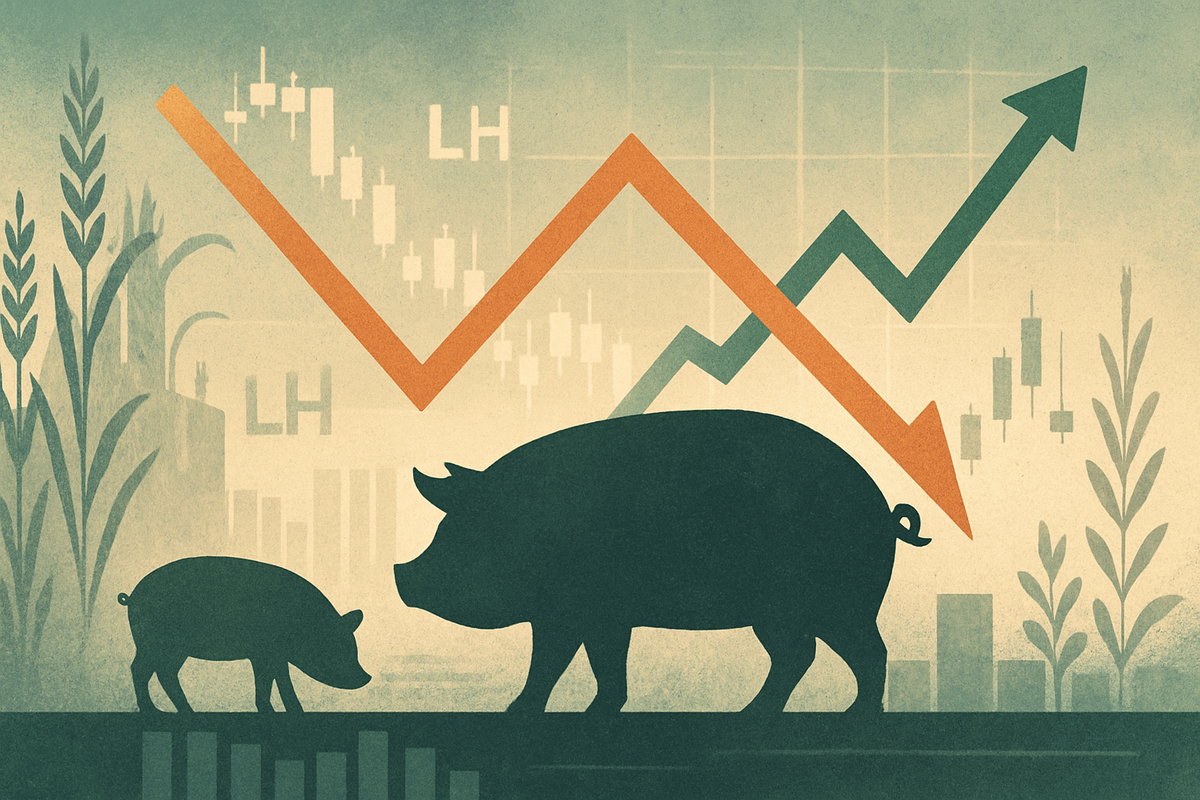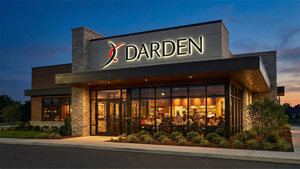Financial News
Lean Hog Market at a Crossroads: Prices Trend Lower Amidst Weakening Fundamentals and Global Headwinds

Chicago, IL – October 9, 2025 – The lean hog futures market is currently experiencing a notable downturn, with prices trending lower as market sentiment suggests a potential top has been reached after a period of bullish momentum. This shift is prompting investors to re-evaluate strategies and consider the implications of weakening fundamentals, increased supply, and persistent global trade challenges. The immediate outlook points to continued bearish pressure, although underlying factors may provide some floor to drastic declines.
Detailed Market Dynamics and Influential Factors
Lean hog prices have been on a consistent downward trajectory in early October 2025, marking multiple consecutive days of losses. December lean hog futures, for instance, have exhibited a sideways-to-lower bias, with trading ranges projected between $85.00 and $90.00. On October 9, 2025, Lean Hogs fell to 97.47 USd/Lbs, a slight decrease from the previous day, while October 8 saw December lean hogs close at a six-week low of 86.100 cents per pound. The CME Lean Hog Index has mirrored this decline, dropping to $101.42 by October 6 and $103.70 by October 3, reflecting a broader market weakening.
Several critical factors are converging to drive this bearish sentiment. Shorter-term speculative traders are actively engaging in profit-taking, indicating a fading of the bullish momentum that characterized earlier periods. This profit-taking is often a precursor to a market top formation. Beyond speculative activity, fundamental weaknesses are becoming more apparent in both the cash and fresh pork markets. Average hog weights are on the rise, suggesting that producers may be holding animals longer, which could lead to an oversupply of market-ready hogs. Concurrently, declining pork cutout values, a key indicator of wholesale pork prices, signal a slowdown in domestic consumer demand for pork products.
Globally, China remains a significant variable. Despite government efforts to curb production, China's pork prices have plummeted to new lows due to persistent oversupply and weak consumption, significantly impacting global demand for U.S. pork. Furthermore, China's ongoing trade restrictions, including tariffs and sanitary barriers, continue to limit U.S. pork exports to what was once a crucial market. Adding to the market's unease are concerns surrounding a potential U.S. government shutdown, which, if prolonged, could heighten risk aversion and potentially dampen consumer confidence and demand. Initial market reactions have been predominantly bearish, with analysts noting "serious near-term technical damage" to futures market charts, characterized by a bearish broadening pattern that reinforces the view of a market top.
Corporate Fortunes: Winners and Losers in a Declining Hog Market
The current downward trend in lean hog prices is creating a distinct divide between potential winners and losers within the agricultural and food processing sectors. For companies whose primary business involves transforming live hogs into consumer-ready pork products, this decline in raw material costs presents a significant opportunity for margin expansion. Conversely, businesses focused solely on hog production are likely to face considerable headwinds to their profitability.
Pork processors and packers stand to benefit most from cheaper lean hogs. Companies such as Tyson Foods (NYSE: TSN), one of the world's largest protein producers, will see their input costs for their substantial pork processing operations decrease. This reduction in raw material expense can directly translate to improved profitability within their pork segment, assuming wholesale and retail pork prices do not fall at an equivalent or faster rate. Similarly, Hormel Foods (NYSE: HRL), known for its diverse portfolio of branded food products, including many pork-based items, could experience enhanced margins. However, it's crucial to note that past instances have shown that rapid declines in finished pork product prices can still pressure processor margins, as Hormel has reported previously. Global meat processing giant JBS S.A. (OTCQX: JBSAY), with its extensive pork operations, is also well-positioned to capitalize on lower hog prices to boost its bottom line. While Smithfield Foods (SFD), the largest U.S. pork producer, has been emphasizing packaged meats and is potentially public after an IPO filing in January 2025, its profitability would similarly benefit from reduced input costs for its processing divisions, though it has also cited "pricing pressures in the pork industry" where pork prices declined faster than hog prices, pressing margins.
On the other side of the equation, hog producers and farmers face a challenging environment. Their revenue is directly tied to the price they receive for live hogs, meaning that a sustained downward trend directly impacts their top-line earnings. While many large producers are integrated into processing, pure-play hog farming operations or segments heavily reliant on live hog sales will experience significant pressure on their operating margins. If their production costs—including feed, labor, and veterinary care—do not decrease proportionally to the falling hog prices, these producers could face tighter margins, or even losses, potentially leading to industry consolidation. The interplay of consumer demand, export markets, and regulatory changes further complicates this dynamic. While lower wholesale prices for pork could stimulate consumer demand, mid-2023 reports indicated softer demand for pork as consumers shifted to other proteins. However, robust domestic demand was cited as a factor supporting higher hog prices earlier in 2025, suggesting that current lower prices might yet move more product. Additionally, regulatory changes like California's Proposition 12, which mandates specific space requirements for breeding pigs, could increase production costs for farmers targeting that market, further squeezing profitability regardless of market prices.
Analyzing the Wider Significance: Industry Trends and Ripple Effects
The current downward pressure on lean hog prices in early October 2025, while significant in the short term, must be viewed within a broader context of industry trends that have largely pointed towards a more optimistic outlook for the year. While recent weakening cash fundamentals and profit-taking have contributed to the dip, the underlying narrative for 2025 has been one of anticipated price increases compared to the previous year, driven by tighter supplies and robust domestic demand. The USDA, for instance, had forecasted a 9.3% year-over-year rise in hog prices for 2025, reflecting expectations of stronger prices due to a slight decrease in overall pork production and strong consumer appetite.
This situation fits into several overarching industry trends. Firstly, supply constraints and productivity remain a critical factor. Despite advancements in sow productivity, the U.S. breeding herd has experienced slow growth or contraction, limiting overall pig crop and slaughter numbers. Disease outbreaks, notably Porcine Reproductive and Respiratory Syndrome (PRRSv) and globally, African Swine Fever (ASF), continue to pose significant threats, impacting production and export capabilities and contributing to tighter supplies. Secondly, favorable demand dynamics play a crucial role. Pork maintains its position as a highly competitive and affordable protein alternative, especially as beef prices remain elevated. Global meat consumption is projected to rise, with pork expected to continue as a leading protein, buoyed by growing populations and increasing disposable incomes in many regions. Thirdly, manageable feed costs have been a supportive factor for producer margins throughout much of 2025, helping to offset other production expenses. Lastly, global trade volatility continues to cast a long shadow, with fluctuating import trends and potential new tariff actions from the U.S. administration creating uncertainty for export-reliant producers.
The ripple effects of lean hog price movements are extensive. For pork producers, recent periods of profitability in 2024 and early 2025, aided by lower feed costs, offered a much-needed reprieve after significant losses in previous years. However, the current short-term weakening of cash prices could quickly erode these margins, particularly for less efficient operations, emphasizing the need for sustained profitability to attract investment and prevent further herd contraction. For competitors in the protein market, such as beef and poultry, pork's relative affordability could lead to consumers shifting away from more expensive meats, potentially increasing pork's market share. Partners across the supply chain are also affected: feed suppliers benefit from manageable feed costs but could see reduced demand if hog prices remain low; processors, who have aggressively competed for limited slaughter-ready hogs, might find some easing of pressure with declining hog prices, though tight supplies still present operational challenges; and retailers and foodservice providers are likely to leverage pork's affordability through promotions to attract budget-conscious consumers, with demand for pork expected to rise in regions like North America and Brazil.
Regulatory and policy implications are substantial. The potential for new U.S. trade policies, particularly the imposition of tariffs on imports from key trading partners, remains a major concern. Such measures could invite retaliatory tariffs, negatively impacting U.S. pork exports and leading to lower domestic hog prices. China's existing 125% tariff on U.S. pork has already significantly redirected export flows. Domestically, regulations like California's Proposition 12 continue to present challenges regarding animal welfare standards for pork sold in the state, potentially increasing production costs. Furthermore, the expected new farm bill in 2025 could introduce new regulations affecting U.S. pork competitiveness, and ongoing investments in biosecurity and disease management policies are critical in the face of threats from diseases like PRRSv and ASF. Historically, the industry has seen significant volatility; the 2018 trade disruptions, for example, led to an estimated 12% decline in U.S. hog prices, illustrating the profound impact of trade disputes. Producers also faced prolonged losses in late 2022 and much of 2023, which led to herd contraction, underscoring how sustained low prices force difficult decisions and industry consolidation. These historical precedents serve as stark reminders of the industry's vulnerability to external shocks and policy shifts.
What Comes Next: Navigating Volatility and Strategic Shifts
The lean hog market, currently grappling with a downward trend in October 2025, faces a complex future shaped by a confluence of supply dynamics, evolving demand, geopolitical shifts, and broader economic conditions. For investors and industry participants, understanding the short-term turbulence and long-term possibilities is crucial for strategic adaptation.
In the short-term (late 2025 - early 2026), continued volatility and potential for further price declines are distinct possibilities. The technical damage to lean hog futures charts in early October, coupled with bearish indicators, suggests that selling pressure may persist. However, several factors could limit drastic drops. Futures trading at a discount to the cash hog index might provide some resistance, and seasonal trends often show the cash hog index rising into early October, which could spur corrective buying. Pork's continued affordability relative to beef could also bolster consumer demand, offering a floor to prices. Furthermore, the USDA's reduced second-half 2025 pork production forecast, driven by lower slaughter-ready hog availability and ongoing disease pressures like PRRS outbreaks, could tighten supply and provide price support. Export dynamics, while facing increased competition, show resilience with the U.S. pivoting to markets like Japan, Mexico, and South Korea, which could also help stabilize prices.
Looking to the long-term (mid-2026 and beyond), a more optimistic outlook emerges from earlier 2025 projections, forecasting moderate growth and profitability. The USDA had anticipated a 9.3% rise in 2025 hog prices year-over-year. A significant driver for this optimism is the expectation of lower feed costs, stemming from favorable prospects for large U.S. feed grain and oilseed harvests into 2026. This would temper production costs and support producer profitability. The U.S. pork sector's focus on genetic improvements for efficiency and enhanced biosecurity measures against diseases like ASF and PRRS could lead to more stable production. Global demand, particularly from growing markets beyond China, is also expected to contribute to long-term health, with some bullish forecasts even projecting substantial price appreciation for lean hogs by 2026 and beyond.
Strategic pivots and adaptations will be critical across the industry. For producers, optimizing feeding strategies to capitalize on lower feed costs, rigorously upholding biosecurity to mitigate disease risks, and utilizing futures contracts for hedging against price fluctuations (e.g., "hog crush spread") are paramount. Processors must adapt to potentially tighter hog supplies and higher hog weights by optimizing processing schedules and plant efficiencies. Diversifying pork products to meet evolving consumer preferences and addressing potential labor challenges will also be key. For investors, implementing hedging strategies to protect against near-term volatility is advisable. However, considering the potential for long-term price appreciation, strategic long-term positioning might also be warranted, alongside diligent monitoring of USDA reports, feed costs, disease outbreaks, and international trade policy developments.
Market opportunities include pork's continued affordability, which can drive domestic consumer demand, especially as beef prices remain high. Opportunities also lie in diversifying export markets beyond China to growing regions in Asia and Latin America, and leveraging lower projected feed costs to improve producer margins. Advances in genetics and biosecurity offer pathways to more stable and profitable production. Conversely, challenges loom large, primarily stemming from ongoing trade tensions and potential new tariffs, which could severely impact export volumes. Persistent disease outbreaks remain a constant threat to production. A potential slowing of domestic demand, as indicated by recent declines in pork cutout values, requires careful monitoring, as does increasing export competition from countries like Spain and Brazil. Finally, the uncertainty of a prolonged U.S. government shutdown could create a void of market information, exacerbating volatility.
Potential scenarios for investors range from a "Cautious Optimism" scenario, where low feed costs and steady demand lead to modest but consistent returns, to a "Bearish Continuation" scenario, where accelerated declines due to demand drops or severe disease outbreaks create opportunities for short-sellers. A "Bullish Rebound" scenario, driven by stronger-than-expected demand or the unexpected lifting of trade barriers, could lead to substantial gains for long positions. Navigating these possibilities will require diversified strategies and robust risk management.
Comprehensive Wrap-up: Navigating the Lean Hog Market's Evolving Landscape
The lean hog market in October 2025 finds itself at a pivotal juncture, having experienced a notable downward trend driven by profit-taking, increasing supply indicators, and a softening of domestic demand. While earlier in the year, forecasts pointed to a more bullish outlook, this recent correction underscores the inherent volatility of agricultural commodities and the delicate balance between myriad influencing factors.
The key takeaways from this period include a noticeable rise in federally inspected hog slaughter and average hog weights, signaling increased pork entering the supply chain. This supply surge has coincided with declining pork cutout values, suggesting a potential slowdown in domestic consumer demand. On the futures side, significant profit-taking and long liquidation by traders have amplified the downward pressure, reflecting a broader weakening in cash and fresh pork fundamentals. Furthermore, the U.S. pork export market faces persistent headwinds, including increased global competition and the enduring impact of China's 125% tariff, necessitating continued diversification to alternative markets.
Moving forward, the lean hog market presents a mixed outlook. While the immediate bearish sentiment may persist due to technical damage on charts, some models project a recovery, with lean hog prices potentially rising by the end of Q4 2025 and into 2026. Potential tailwinds include improved producer margins fueled by retreating feed costs, which were a significant factor in turning profitability around from 2023 losses. Elevated prices for competing proteins like beef and chicken could continue to bolster demand for pork as a more affordable alternative. Technical support at key price levels may also limit sharp declines, and some analyses suggest an underlying long-term uptrend could still be in place. However, lingering headwinds remain, primarily persistent export competition, the potential for continued domestic demand volatility, and structural risks such as disease outbreaks (e.g., PRRS) and geopolitical tensions that could disrupt market stability.
The significance and lasting impact of this October 2025 downturn lie in its role as a critical market adjustment. It highlights the inherent volatility of the lean hog market and the delicate balance between supply, demand, and external economic factors. While the industry saw a remarkable turnaround in profitability from significant losses in 2023 to projected profits in 2025, this recent correction underscores that sustained profitability is not guaranteed. The lasting impact will hinge on whether this is a temporary consolidation after a strong run or the beginning of a more prolonged period of lower prices driven by fundamental shifts in trade dynamics and domestic consumption patterns. The ability of the U.S. pork sector to adapt to intensifying export competition and manage domestic supply will be crucial.
For investors, diligent monitoring of key indicators will be paramount in the coming months. They should closely watch:
- Pork Export Sales Reports: For any signs of improvement or deterioration in international demand, especially from emerging markets.
- Domestic Pork Cutout Values and Hog Weights: As critical real-time indicators of domestic demand and processing capacity. A reversal of recent declines would signal strengthening domestic absorption.
- USDA Hogs and Pigs Reports: For vital insights into future supply based on breeding herd numbers and farrowing intentions.
- Feed Cost Trends: As fluctuations in corn and soybean meal prices directly impact producer margins.
- Disease Monitoring: To stay informed about potential outbreaks of swine diseases that could significantly affect supply.
- Broader Economic Indicators: As general economic health and consumer spending habits influence overall meat demand.
- Technical Chart Patterns: For futures traders, observing support and resistance levels, moving averages, and chart formations will be essential for identifying potential price reversals or continuation patterns.
By carefully tracking these factors, investors can better assess the market's direction and strategically position themselves to respond to evolving conditions in the lean hog sector.
This content is intended for informational purposes only and is not financial advice
More News
View More




Recent Quotes
View MoreQuotes delayed at least 20 minutes.
By accessing this page, you agree to the Privacy Policy and Terms Of Service.



